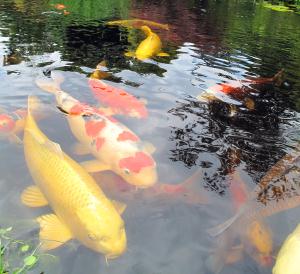
Koi are the premier fresh water aquarium fish in the world. My opinion, but these gorgeous fish come in a huge variety of colors and patterns and there’s a lot of pleasure just watching them.
Well kept fish ponds and aquariums are pleasant to look at and have a calming on people. How often have you seen an aquarium in a dentist’s office?
Fish ponds can be expensive to build and can require a fair amount of maintenance. But a pond can be built without breaking the bank if it’s planned and carefully thought out.
A lot of DIY fish pond builders are successful, but many soon realize that it takes a fair amount of expertise to successfully build and maintain a koi pond. If you want a pond without the expense, ask the question “How can I save money”? Yes, building a pond can take a lot time and money; but, if you are even remotely handy with tools and don’t mind putting in some sweat equity, a few simple suggestions should put you well on your way to owning your very own koi pond.
Most people think a pond is an in-ground feature, but there’s no reason to believe that in-ground is absolutely necessary. Consider building an above ground pond the same way you would build a wading pool that was a couple of feet deep. You could even make part of it in-ground to make part of it deeper and still save a bunch of money.
How To Build A Pond
The size of the pool determines how much it costs to build and how many fish it can support. You may be able to save hundreds over the cost of a comparably sized kit. Follow these steps:
1. Determine how much area you want to devote to your pool. A 10 feet by 12 feet pool that is two feet deep is a good size and makes the calculations easy. 10X12X2 = 240 cubic feet of pool. Multiply this by 7.5 gallons and you end up with an 1800 gallon above ground pool that will support five or six fish easily. If you want to make the pond deeper, it can easily be done by digging a hole and make part of the pond be below ground level.
2. Build the pond structure out of 4X6 or 6X6 timbers. You may have to cut some of them to make the joints, but this will allow you to overlay the joints and give the structure added strength to contain the pressure of the water. Drill holes through the timbers about a foot into the ground to hold the structure in place. You can also drill holes for the skimmer and water lines. Water lines and valves are ordinary PVC and are very reasonably priced.
3. Find a suitable place to put a utility area with the pump, filter and water purifying equipment. I would put it in an out of the way spot that can be covered with a shelter or hidden with plants. Run the water lines from the pond structure and electrical conduit to the utility area. Make sure you seal the flanges used with the lines and I suggest a valve installed in each line to isolate the pond when you want to do any maintenance on the utilities.
4. Install a liner. It has to be a heavy gauge plastic liner. This is one area I would not go cheap on. The heavier, the better and I suggest at least 1/2 inch of styrofoam or vermiculite under the floor and sides of the liner to cushion it against the ground and the sides of the timbers.
The liner should be at least 45 mils thick and (if possible) cover the entire area inside your pool without any seams. Finding the right koi pond liner can be as easy as doing an online search and selecting the liner.
Another option is to buy a pond kit, but before you spend any money, find out what’s in the kit, compare prices and don’t spend any more than you have to get the right kit for your yard.
Finding the right koi pond kit that has everything in it you need to build a koi or garden pond could be as easy as heading down to your local hardware store or going online to do your shopping.
5. Fill the pond with water to just above the flanges and check for water leaks in the plumbing. If you find any, pump the water out and fix them. Then continue filling until the water level is about six inches below the top of the structure.
6. Start pumping the water, use any dechlorination method you want and let the water circulate for about a week to stabilize the temperature and quality before you put any fish into it. This is also a good time to install plants in and around the pond to provide shade and food for your koi.
7. Put your koi in the pond and enjoy.
8. Start thinking about other things you can do. This type of construction makes it easy to add waterfalls or fountains. Let your imagination be your guide.
Getting the best information is the first step toward having a great Koi fish pond and information is available now. The “The Beginner’s Guide to Raising Healthy Koi“ offers the latest up-to-date information on building your pond and keeping your fish healthy, vibrant and happy. Get a copy by clicking here now.